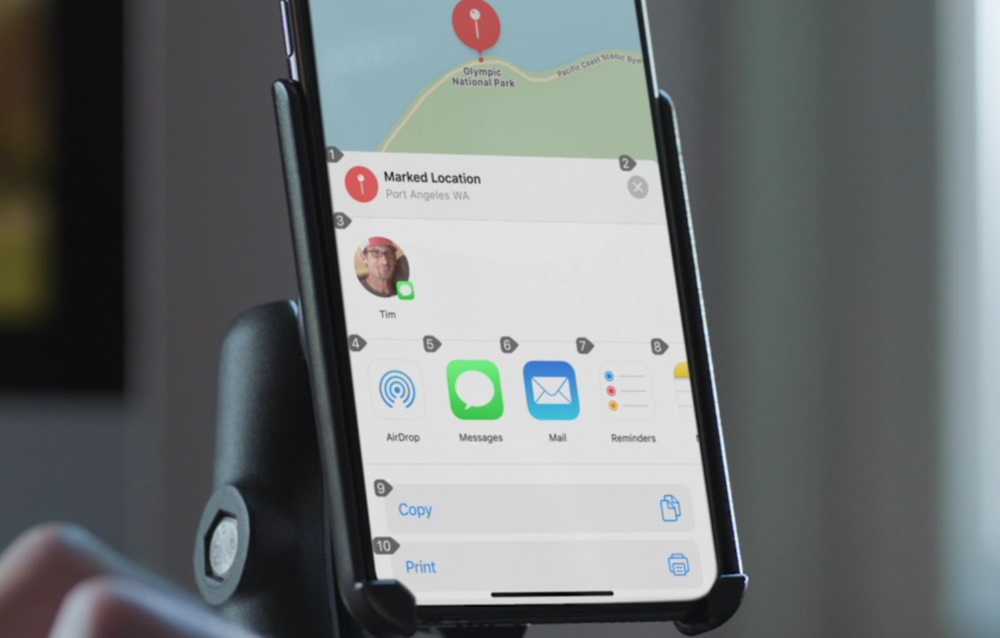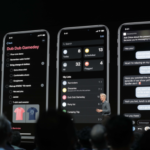Apple attacks Facebook by becoming the asocial network
Sharing with everyone is passé and more than a little bit scary these days. We want to send photos to friends without posting them publicly. We want to reminisce without being permanently defined by our timelines. And we want the utility of apps without giving away our contact info to developers.
 The problem is that this philosophy is hard to monetize for a social network that needs to maximize broadcasted content and engagement to score ad views. But it’s easy to monetize if you sell the phone and then let people be as private as they want on it. That’s why today at WWDC, Apple showed off changes that turn iOS into the asocial network — software that mimics the tools of Facebook but without the pressure to overshare.
The problem is that this philosophy is hard to monetize for a social network that needs to maximize broadcasted content and engagement to score ad views. But it’s easy to monetize if you sell the phone and then let people be as private as they want on it. That’s why today at WWDC, Apple showed off changes that turn iOS into the asocial network — software that mimics the tools of Facebook but without the pressure to overshare.
Most stunningly, Apple will require apps that offer third-party login options like those from Facebook and Google to integrate its new Sign In With Apple feature that lets users hide their email addresses from developers. It’s a power move that makes Facebook look wreckless with your contact info by comparison.
Privacy has been a core Apple talking point for years, from the iPhone’s secure enclave and FaceID to message encryption to protection against tracking. But those safeguards have been focused on getting out of the way to let Apple’s products to ‘just work’. Increasingly, Apple is moving privacy further forward in the user experience to highlight how you can get more out of sharing less. That’s a wise strategy since the company has proven its inability to build full scale social networks out of Ping, Apple Music Connect, and iMessage.
“At Apple, we believe privacy is a fundamental human right and we engineer it into every single thing we do” said Apple SVP Craig Federighi . Mark Zuckerberg declared “The future is private” at Facebook’s F8 conference a month ago, but proved it wasn’t his company’s past or present by failing to launch products that protect users. Now like Google did at I/O a few weeks ago with a slew of privacy tech launches, Apple is actually living up to its talking points with today’s beta release of iOS 13.
Photo Message Recommendations – When you bring up the Share Sheet for a photo or video in iOS 13, Apple will recommend people to send it to over iMessage or Mail based on who you frequently share with and if friends appear in the content. With a few taps you can privately deliver your imagery to a slew of your closest friends and favorite group chats, which could eliminate the need to post it more widely on Facebook or Instagram.

Asocial Media Tools – Instagram offers no way to download a photo or video you edit without first posting it to the feed first. That greedy growth hack leaves room for Apple to usurp more of the creative process. iOS 13 will let you edit videos for lighting, color, contrast, and more plus rotate clips you accidentally shot sideways — all which Instagram and Facebook can’t do. Forgoing the social network side lets Apple focus on tools that you’re free to use however you want.
And with the new Photo Day feature, Apple automatically hides and emphasizes different photos from each day to create magazine-style layouts. These ignite nostalgia and create a visual diary without the embarassment of all that content being on social media to power those TimeHop and Facebook On This Day features.

Memoji – To date, Apple’s interest in animated avatar masks that look like you has centered around FaceTime and video messages. But now it’s realizing how these virtual mini-me’s can enhance privacy while connecting more deeply. iOS 13 will let you opt to share your name and Memoji (or a real photo) as your message thread thumbnail in iMessage so new conversation partners like group chat friends-of-friends can better identify you without showing strangers your actual face. And Memoji can now be used as pre-generated stickers in chat, making it a direct competitor to Snapchat’s Bitmoji and Facebook’s Avatars that just launched today.
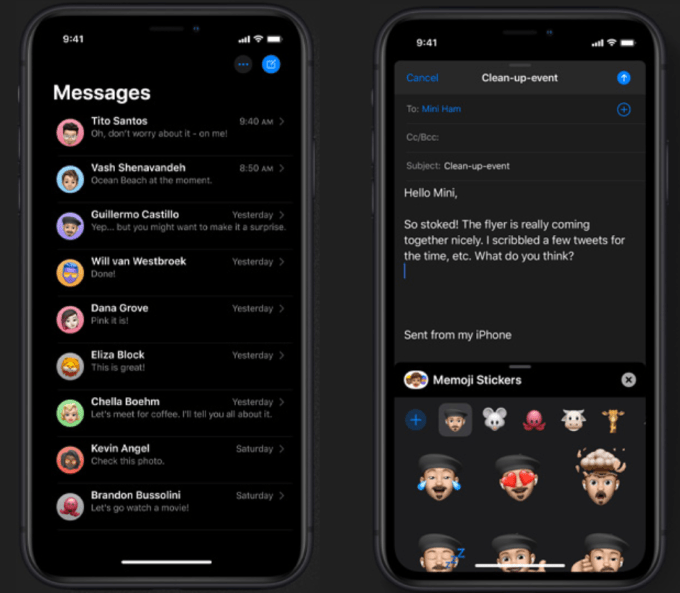
AirPods Audio Sharing – What if instead of trumpeting what you’re listening to on social media or fumbling to text a song link to a friend, they could just instantly pipe the sound into their headphones too so you’re rocking out in sync? That’s how the upcoming AirPods Audio Sharing works to let you exchange music privately over Bluetooth without exposing your guilty pleasure jams.
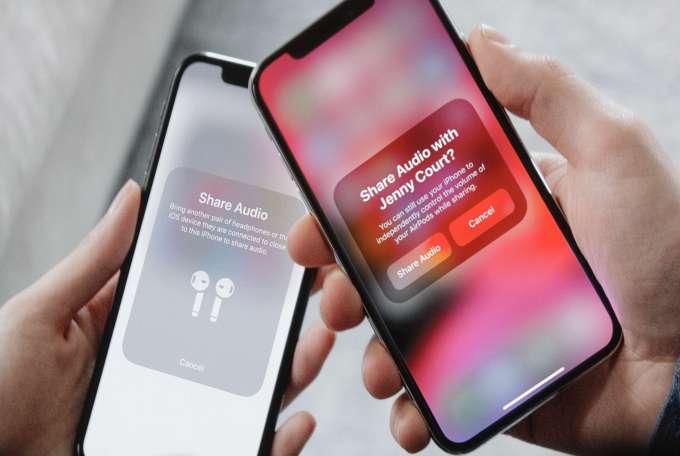
Sign In With Apple, Not Facebook
Apple’s most brazen attack saw it call out the social network by name on screen at WWDC. Flashing logos for “Sign In With Facebook” and “Sign In With Google” that are popular for joining new apps without setting up an account, Federighi noted that “This can be convenient, but it also can come at the cost of your privacy. Your personal information sometimes gets shared behind the scenes. These logins can be used to track you.”
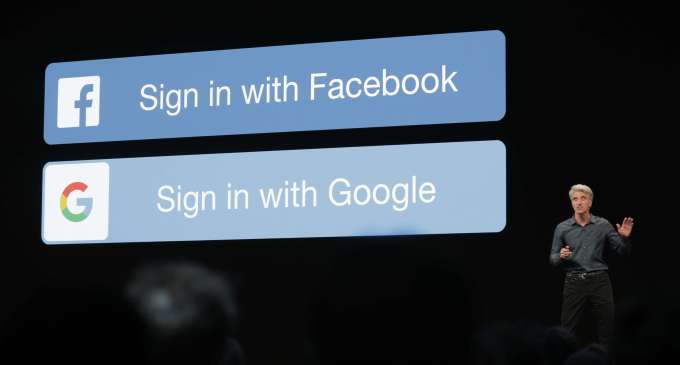
As an alternative, Apple is launching “Sign In With Apple”. It uses FaceID in lieu of asking you to create a new username and password to register for a third-party app. Federighi told users they can opt to hide their email addresses from app developers and instead have Apple provide a randomized proxy address that forwards to their real one. That means users can permanently block spam messages from the app, prevent the developer from sharing or selling their contact info, and avoid being targeted with marketing via their email address as with Facebook Custom Audience ads.
The announcement drew the loudest cheers of any at WWDC. And it seems Apple is determined to wring as much competitive advantage out of its Sign In feature as possible. You might imagine that adoption by developers would be outside of Apple’s control, and it’d have to prove it drove more lifetime value than login options that always provide a user’s real email.
But while Apple failed to mention this on stage, the fine print of its developer news brief notes that “Sign In with Apple will be available for beta testing this summer. It will be required as an option for users in apps that support third-party sign-in when it is commercially available later this year.”
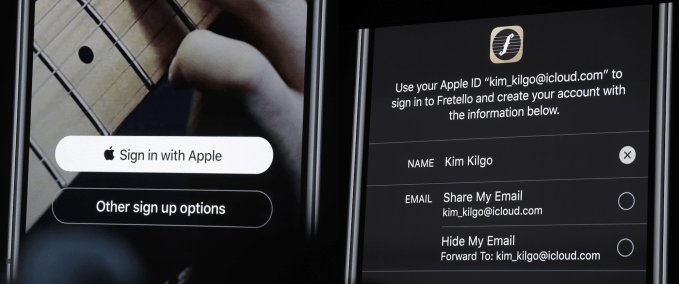
Sure, developers want to maximize signups by minimizing onboarding friction, which is why Sign In With features that don’t make you remember more passwords have grown popular. Adding the Apple sign-in option should theoretically help. But developers also rely on sucking in email addresses to wake up lapsed users with message blasts, target them and people similar to them with reengagement or install ads, and exclude existing users to save money when buying ads to recruit new users.
If developers fear Sign In With Apple’s proxy email address feature will hurt them by cannibalizing registrations made with Facebook or Google that don’t offer users a way to hide their real contact info more than the convenience of a third sign-in option will help, they may try their best to bury or minimize the mandatory feature. Apple might have to incentivize growth for developers in other ways, such as heavily promoting them in the App Store if they prioritize its login option to offset the lifetime value per user decline from the loss of contact info. Unless compelled by some moral imperative, developers aren’t likely to risk their business any more than they have to in the name of privacy.

It’s here that Apple will learn that taking the high road can have its speed bumps. It might monetize selling hardware, but its developer partners often still rely on constantly grabbing our attention.
Privacy is often an abstract concept to the mainstream consumer, that doesn’t dictate their decisions, judging by Facebook’s continued user growth. That’s why promotional campaigns around the philosophy of privacy can seem to have little impact. But by building products and platforms that are objectively more useful yet more privacy-friendly than those of competitors, Apple can allow natural market forces to sweep users in the right direction — which just happens to lead into its shiny retail stores.
Powered by WPeMatico
Apple’s Voice Control improves accessibility OS-wide on all its devices
Apple is known for fluid, intuitive user interfaces, but none of that matters if you can’t click, tap, or drag because you don’t have a finger to do so with. For users with disabilities the company is doubling down on voice-based accessibility with the powerful new Voice Control feature on Macs and iOS (and iPadOS) devices.
Many devices already support rich dictation, and of course Apple’s phones and computers have used voice-based commands for years (I remember talking to my Quadra). But this is a big step forward that makes voice controls close to universal — and it all works offline.
The basic idea of Voice Control is that the user has both set commands and context-specific ones. Set commands are things like “Open Garage Band” or “File menu” or “Tap send.” And of course some intelligence has gone into making sure you’re actually saying the command and not writing it, like in that last sentence.
But that doesn’t work when you have an interface that pops up with lots of different buttons, fields, and labels. And even if every button or menu item could be called by name, it might be difficult or time-consuming to speak everything out loud.
To fix this Apple simply attaches a number to every UI item in the foreground, which a user can show by saying “show numbers.” Then they can simply speak the number or modify it with another command, like “tap 22.” You can see a basic workflow below, though of course without the audio cues it loses a bit:
Remember that these numbers may be more easily referenced by someone with little or no vocal ability, and could in fact be selected from using a simpler input like a dial or blow tube. Gaze tracking is good but it has its limitations, and this is a good alternative.
For something like maps, where you could click anywhere, there’s a grid system for selecting where to zoom in or click. Just like Blade Runner! Other gestures like scrolling and dragging are likewise supported.
Dictation has been around for a bit but it’s been improved as well; You can select and replace entire phrases, like “Replace ‘be right back’ with ‘on my way.’ ” Other little improvements will be noted and appreciated by those who use the tool often.
All the voice processing is done offline, which makes it both quick and robust to things like signal problems or use in foreign countries where data might be hard to come by. And the intelligence built into Siri lets it recognize names and context-specific words that may not be part of the base vocabulary. Improved dictation means selecting emoji and adding dictionary items is a breeze.
Right now Voice Control is supported by all native apps, and third party apps that use Apple’s accessibility API should be able to take advantage of it easily. And even if they don’t do it specifically, numbers and grids should still work just fine, since all the OS needs to know are the locations of the UI items. These improvements should appear in accessibility options as soon as a device is updated to iOS 13 or Catalina.
Powered by WPeMatico
Fitness startup Mirror nears $300M valuation with fresh funding
Today, Peloton is a bonafide success. The company, which sells $2,245 internet-connected exercise bikes, boasts a $4 billion valuation and a cult following.
That hasn’t always been the case. For years, Peloton battled for venture capital investment and struggled to attract buyers. Now that it’s proven the market for tech-enabled home exercise equipment and affiliated subscription products, a whole bunch of startups are chasing down the same customer segment.
Mirror, a New York-based company that sells $1,495 full-length mirrors that double as interactive home gyms, is closing in a round of funding expected to reach $36 million, sources and Delaware stock filings confirm, at a valuation just under $300 million. It’s unclear who has signed on to lead the round; we’ve heard a number of high-profile firms looked at Mirror’s books and passed. The company has previously raised a total of $38 million from Spark Capital, First Round Capital, Lerer Hippeau, BoxGroup and more.
Mirror declined to comment for this story.
Like Peloton, Mirror is sold for a hefty fee with a subscription to the service’s unlimited live and on-demand workouts that comes at an additional cost. The company hasn’t disclosed subscriber numbers, though The New York Times reported in February the business was selling $1 million worth of Mirrors — or some 650 units — per month.
The company has not only benefited from the Peloton effect, but also from a near-immediate interest from celebrities and influencers in its product. Kate Hudson, Alicia Keys, Reese Witherspoon, Jennifer Aniston and Gwyneth Paltrow are among the many celebrities to have publicly boasted about Mirror, undoubtedly boosting sales for the up-and-coming startup.
Venture capitalists were quick to show support for Mirror, too; in fact, the business attracted money at a $200 million valuation prior to launching its first product. Mirror began selling its sleek equipment, dubbed by The New York Times as “The Most Narcissistic Exercise Equipment Ever,” in September.

SAN FRANCISCO, CA – SEPTEMBER 06: Mirror Founder and CEO Brynn Putnam (L) and moderator Lucas Matney speak onstage during Day 2 of TechCrunch Disrupt SF 2018 at Moscone Center on September 6, 2018, in San Francisco, California. (Photo by Steve Jennings/Getty Images for TechCrunch)
The round comes amid a distinct boom in funding for fitness-related startups evidenced not only by Peloton’s mammoth valuation and hyped-over initial public offering expected soon but by the rapid uptick in small upstarts looking to capitalize on rising interest in fitness apps and equipment. In total, VCs bet some $2 billion on U.S. fitness startups in 2018, a record amount of funding for the space. So far this year, nearly $500 million has been allocated to the growing sector, per PitchBook, as entrepreneurs strive to bring the gym into the home.
Tonal, which sells personal exercise equipment that combines on-demand training with smart features, is among a small class of venture-backed fitness companies to have accumulated a large following. The company has raised $91.7 million in equity funding at a valuation of $185 million, according to PitchBook, from investors including L Catterton, Shasta Ventures, Mayfield and Sapphire Sport.
When it comes to early-stage efforts, there’s no shortage of recent fundraises. Last week, Livekick, which gives customers access to one-on-one personal training and yoga from their home, closed a $3 million seed round led by Firstime VC. Two weeks ago, fitness startup Future secured an $8.5 million round led by Kleiner Perkins’ Mamoon Hamid. For a $150 monthly fee, Future assigns personalized workout plans and a coach who tracks customers’ fitness activity through an Apple Watch. To keep users committed to their workout regimens, Future sends daily text messages with motivational feedback.
The AI-based personal training company Aaptiv, Plankk, which sells live fitness lessons led by Instagram stars, and audio coaching app Eastnine, have also recently launched.
Mirror was founded in late 2016 by Brynn Putnam, an entrepreneur behind Refine Method, a chain of boutique fitness studios located in New York. The former professional dancer spoke to TechCrunch’s Lucas Matney at Disrupt San Francisco in September about the future of the business.
“[We want] to enhance the human touch rather than to replace it,” Putnam said. “Our goal is not to be the next treadmill in your life, our goal is to be the next screen in your home,” Putnam said.
Ultimately, Putnam added, Mirror plans to scale beyond fitness content with potential extensions including physical therapy, fashion, beauty and education.
“We have the ability to create personalized premium content across a wide range of verticals, with fitness being our first vertical,” Putnam said.
Powered by WPeMatico
Cookware startup Great Jones launches Potline, a text service for recipes and advice
Great Jones, a startup selling pots, pans and even an oven directly to consumers, is introducing a new way to get help in the kitchen.
Potline is a free text message service where anyone can ask for recipe ideas, or get advice when things are going wrong in the middle of the cooking process, or get tips on how to clean up afterwards. Great Jones co-founder Sierra Tishgart argued this is “a really natural extension” of the brand, particularly since the company has already been getting customer service queries that aren’t really about its cookware.
“It’s great to see someone write in to say, ‘Hey I’m cooking for my new girlfriend or boyfriend, and I want a roast chicken recipe,’” Tishgart said.
As for why it’s doing this via text message, she said, “We really want this to feel like that you are in the middle of making pasta and your sauce isn’t landing — how would you look for help there? I would text somebody. We really realized that is just the fastest, most immediate and natural form of communication.”

Initially, Potline will be available from 4pm to 8pm Eastern time on Monday and Wednesday evenings. That’s only eight hours each week, but Tishgart said you’re going to be getting real-time feedback from an actual human being — namely Great Jones customer experience lead Gavy Scelzo.
“We don’t have a large team doing this,” Tishgart added. “This is very much an experiment for us. Gaby is answering the questions. We’re on our own text thread with seven of us in the office contributing, but it’s really going to be relying on Gaby’s expertise [and] a large database of recipes.”
Of course, if it’s successful, Potline could eventually expand to other days and times. Meanwhile, you can try it out for yourself by texting 1-814-BISCUIT.
Powered by WPeMatico
Flash, the e-scooter startup from Delivery Hero founder, re-brands as ‘Circ’ and announces 1M rides
Flash, the micro-mobility startup from Delivery Hero and Team Europe founder Lukasz Gadowski, is re-branding today and disclosing that the e-scooter rental service has clocked up 1 million rides in just 4.5 months since launch.
This, the company claims, is a milestone passed quicker than any of its competitors, although Voi recently announced that it reached 2 million rides in less than 8 months, while I understand that Tier, which launched later than Voi, is on track to hit that same number any day now, if it hasn’t already. The takeaway: e-scooter rentals in Europe remains a hot and fast-growing market to be in.
Quietly launched in Zurich, Switzerland in mid-January this year, Berlin-based Circ says it has since expanded to 21 cities across 7 countries. The re-brand is in preparation for further international expansion, with Germany up next to coincide with new German regulations permitting e-scooter services.
With regards to the name change, I’m told the decision was both practical and more conceptual. When people think of “flash” they tend to think of lightning or comic book superheroes, while the word itself is intrinsically linked with connotations of speed. While newly named Circ has moved very fast to reach 1 million rides, riding fast is not what the company is about.
“We wanted a name that better reflects who we are and how seriously we take the responsibility of moving people. Circ is all about circles, connections and there is great symmetry with what we do, working with others to help people move around their city in a reliable, safe and enjoyable way,” a company spokesperson tells me.
Reading between the lines, it’s almost certain that the startup is also thinking about its brand beyond e-scooters alone. Gadowski has always described the company as a “micro-mobility” service that isn’t just concerned with scooters and one that wants to play an integral role within a city’s broader transportation system.
On that note, Circ says it has joined the Union Internationale des Transports Publics (UITP), the worldwide association for public transportation. It has also formed a partnership with Swiss public transport operator Swiss Federal Railways (Schweizerische Bundesbahnen, SBB).
“The comprehensive partnership entails the creation of designated parking spaces at key strategic locations in railway stations and explores digital integration as Circ and SBB introduce ways to create seamless mobility for rail and e-scooter users,” says Circ.
Powered by WPeMatico
Is your event strategy paying off? How to calculate your event ROI
Events have increasingly become an important channel in the marketing mix, despite how notoriously “impossible” it is to measure the ROI, or return on investment. When people show up to your event, they are willingly giving you their attention for hours on end – not trying to avoid attention-grabbing ads.
A well produced experience provides a great way to reach outside of your existing networks, build a pipeline of new customers, transform existing customers into superfans, and position your brand as a thought leader. In 2017, only 7% of marketers said that events were their most important marketing channel. Last year, that number rose to 41% according to a survey done by Bizzabo.
As the founder of Happily, the largest network of event producers in the United States, I’ve had backstage access to thousands of events – some wildly successful like TED and others that didn’t ever get traction in building an engaged community.
What has defined the successful ones?
The experiential marketing industry has long struggled to measure success in a meaningful way. They propose all the same KPIs (key performance indicators), but rarely do those KPIs provide a benchmark to determine if an event is successful or give marketers the ability to tell what worked and what didn’t. They especially fall down when customers aren’t won until months after an event.
Powered by WPeMatico
With iOS 13, Apple delivers new features to court users in India
Apple has finally listened to its small, but slowly growing user base in India. The iPhone-maker today announced a range of features in iOS 13 that are designed to appease users in the world’s second largest smartphone market.
First up, the company says its Siri voice assistant now offers all new and “more natural” Indian English male and female voices. It has also introduced a bilingual keyboard, featuring support for Hindi and English languages. The keyboard offers typing predictions in Devanagari Hindi that can suggest the next word as a user types and it learns from their typing over time.
Additionally, the keyboard in iOS 13 supports all of 22 Indian languages, with the inclusion of 15 new Indian language keyboards: Assamese, Bodo, Dogri, Kashmiri (Devanagari, Arabic), Konkani (Devanagari), Manipuri (Bangla, Meetei Mayek), Maithili, Nepali, Sanskrit, Santali (Devanagari, Ol Chiki), and Sindhi (Devanagari, Arabic).
The addition of these features comes as Apple cautiously grows more serious about India, where it holds about just 1% of the smartphone market share, according to research firm Counterpoint. Even as smartphone shipment is declining in much of the world, India has emerged as the fastest growing market for handsets in recent years. According to Counterpoint, more than 145 million smartphones shipped in India last year, up 10% year-over-year.
But users in India have long complained about Apple services not being fully optimized for local conditions. Siri, for instance, has so far offered limited functionalities in India, and many Apple services such as Apple Pay and Apple News are yet to launch in the nation.
The upcoming version of iOS, which will ship to a range of iPhone handsets later this year, also includes four new system fonts in Indian languages: Gurmukhi, Kannada, Odia, and Gujarati. These will “help deliver greater clarity and ease when reading in apps like Safari, typing in Messages and Mail, or swiping through Contacts,” the company said in a statement.
Additionally, there are 30 new document fonts for Indian languages Hindi, Marathi, Nepali, Sanskrit, Bengali, Assamese, Tamil, Telugu, Gujarati, Kannada, Gurmukhi, Malayalam, Odia, and Urdu.
Apple says iOS 13 will also enable improved video downloading option for patchy networks. It says users in India can now set an optimized time of the day in video streaming apps such as Hotstar and Netflix for downloading videos. Consumption of video apps is increasingly skyrocketing in India. Just last week, Alibaba said it was investing $100 million in its short video app called Vmate in the nation.
In recent months, Apple has also improved Apple Maps in India. Earlier this year, Apple Maps added support for turn-by-turn navigation, and enabled users to book a cab — from Ola or Uber — directly from within the maps app. The company has also been aggressively hiring people to expand its maps and other software teams in the country, according to job postings on the its site.
Improvements to software aside, Apple has also been working to reduce the cost of iPhones in India, the single major factor for their poor sales in the country. Two years ago, Apple started to assemble the iPhone 7 handset in India. It plans to ramp up its local production in the coming weeks, a person familiar with the matter told TechCrunch.
As part of local government’s ‘Make in India’ program, phone vendors that assemble phones in the country are offered tax and other benefits. Ravi Shankar Prasad, an Indian minister who oversees law and justice, telecom, and electronics and IT departments, said at a press conference earlier today (local time) that Bharatiya Janata Party, the ruling party which was reelected last month, will work on expanding Make in India program as one of its top priorities.
Powered by WPeMatico
Photos on iPhone is about to look completely different
When you need to find a photo on your iPhone, what do you do? There are tons of ways, but let’s be honest. You probably just go to the camera roll and scroll through at lightning speed, trusting your eyes to pick out the target shot. That may change with Apple’s new layout for Photos, which organizes shots into easy-to-browse days, months, and years.
Right now the Photos app is kind of a mess. There are so many ways your photos are organized that it feels like none is the “main” one. The “For You” tab has a best of the last (insert random duration here) and randomly selected photos from random periods; Search shows me “one year ago,” “spring,” “trips,” and “dining” — great, thanks! And even the chronologically listed “Photos” tab has such tiny images that it’s hard to pick out the ones you want. So we all just go to camera roll and scroll and scroll.
That may change with the Days, Months, Years theme Apple just announced at WWDC. Under the default photos tab in the Photos app, you’ll now see a new set of tabs — yeah, probably too many tabs — with the different durations on it.
 The default mode looks a lot like camera roll. But when you hit “Days,” each day shows as a selection of highlighted images, large and mosaiced, and with live photos active. Each day is marked by a full-width shot, so you can easily slide down to the next day — more recent shots are towards the bottom.
The default mode looks a lot like camera roll. But when you hit “Days,” each day shows as a selection of highlighted images, large and mosaiced, and with live photos active. Each day is marked by a full-width shot, so you can easily slide down to the next day — more recent shots are towards the bottom.
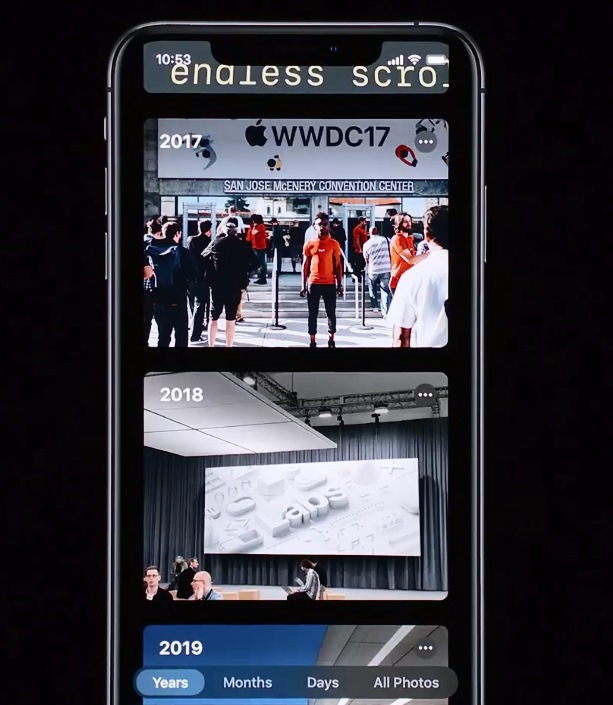 Flip over to Months, and it compresses each calendar month of shots into a handful of events, such as events or locations the system has detected. Years does the same thing, except as the “cover” for each year’s album it shows an image from the same day or period — for example, if it’s someone’s birthday party, you’ll see shots from when you (hopefully) attended their party in years past.
Flip over to Months, and it compresses each calendar month of shots into a handful of events, such as events or locations the system has detected. Years does the same thing, except as the “cover” for each year’s album it shows an image from the same day or period — for example, if it’s someone’s birthday party, you’ll see shots from when you (hopefully) attended their party in years past.
Of course Photos already had a “on this day” type feature, but this makes much more sense to me. You can dive into a year and it breaks into months, and of course months break into days. It’s just a more efficient way of scrubbing through your camera roll — though I have no doubt we’ll still do that from time to time.
In a way this is a minor change to iOS, but because users interact with Photos so much, it could significantly change how you think about getting to the images you want.
Powered by WPeMatico
Should your company move into a co-working space, sublease space or traditional office?
Contributor
It’s a cautionary tale we hear far too often: Company A, hiring staff and growing rapidly, finalized a 10-year lease for office space. One week after move-in they had filled their space to the brim, with engineers sitting on top of sales staff, interns working in the hallways and the CEO operating out of a small conference room.
Company A had backed themselves into a corner, in desperate need for more room with no easy solution to the problem, and looking to swiftly dispose of their inadequate space.
In the startup environment, everything moves at a breakneck pace. Raising venture capital, hiring staff, assembling a board, etc. – all while working day-in and day-out to refine a product or service meant to disrupt the world. With senior staff pulled in different directions, there is little time for a strategic analysis of office space needs.

My team at Colliers specializes in working with technology companies at all stages, from pre-seed to IPO and beyond. We have advised dozens of companies literally from their first day of operations, to others whose market caps are well into the multi-billion dollar range.
We have developed some metrics and strategies that help our clients to grow without having to worry about scheduling an hourly team huddle at the downstairs Starbucks .
We have extensive experience working with companies with offices around the U.S. and world, but a majority of our work is in the New York City area. The analytics and strategy formation for each company is different dependent on a multitude of factors: budget, concrete or tentative headcount projections, timing, etc. – but there are a few baseline rules that can help jumpstart the education process and conversation.
From working with hundreds of technology companies in various states of flux (capital infusion, rapid growth, headcount reduction), we’ve become experts on which office may be the best fit for a company, from a month-to-month WeWork licensing agreement to a long-term lease.
Rarely in the commercial real estate world are issues black-and-white; and strategies are unique to each company. But there are several basic questions that need to be answered when evaluating office space:
- When is co-working an effective solution? What are the pros and cons?
- What about a Sublease? When is that appropriate?
- When is it time to make a long-term commitment to traditional office space?
Powered by WPeMatico
Apple announces iOS 13 with dark mode, updated Apple apps and privacy features
Apple shared some of the new features that you’ll get with the release of iOS 13 this fall. There are a ton of small and big feature updates, and it felt like Apple executives were rushing through the presentation because there are so many things to announce.
“iOS 13 is a huge release packed with lots of capabilities,” VP of Software Engineering Craig Federighi said. But Federighi immediately started with performance improvements.
For instance, Face ID is 30 percent faster. Downloads and updates on the App Store are a lot smaller. Updates are 60 percent smaller on average because your iPhone won’t download the full app every time you get an update. And apps should launch twice as fast.
Dark mode and low-level improvements
Many apps have already adopted dark mode. But Apple is adding system-wide dark mode for iOS 13. With a simple button in Control Center, you’ll be able to switch from a light interface to a dark interface. Native apps, such as Music, Messages and Calendar have all been updated to support dark mode.
Notifications and widgets look darker. When you open an app, Apple is using a solid black background, which should look good on an OLED screen as it won’t emit any light.
The native keyboard now supports typing by swiping from one letter to another. The share sheet has been redesigned with intelligent suggestions based on your most important contacts. In the Music app, you can now see scrolling lyrics.
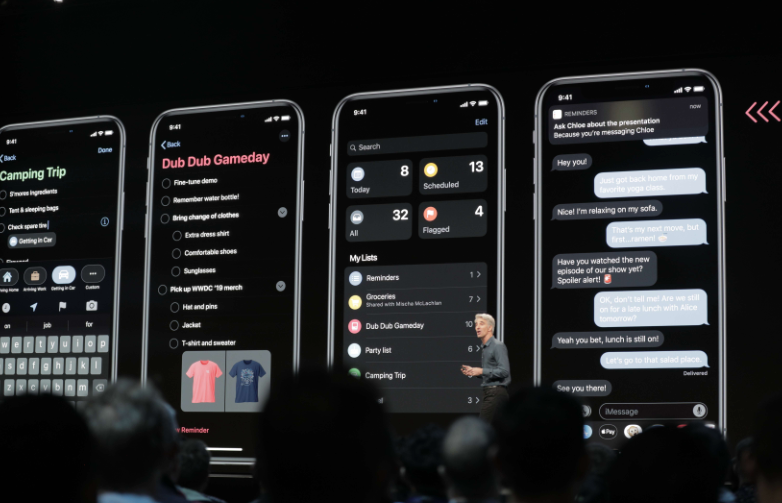
Apple apps get updated
When it comes to first-party apps, Safari has options to change text sizing and settings per website. Mail gets rich text editing. Notes gets a gallery view and folders.
Reminders has been completely redesigned. There’s a new quick type bar to add a task. You can indent tasks below bigger tasks. You can also tag people — they receive a notification in iMessage.
Apple’s Meg Frost also showed the new version of Apple Maps. In addition to improved data in some parts of the U.S., there’s a feature that works just like Google Street View called Look Around. Moving from one location to another in Look Around is incredibly smooth.
There are more updates to Apple Maps, such as the ability to share your ETA with friends, collections of favorite places, the ability to share lists with friends, etc.
Apple will map the U.S. with its own data by the end of 2019, other countries will be upgraded later.

Privacy, privacy, privacy
Apple is updating location tracking in apps. You can share your location with an app just once. Third-party developers soon won’t be able to share details about your Wi-Fi network or Bluetooth signal, which should put an end to many privacy scandals.
Apple is also going to compete with “Sign in with Facebook” or “Sign in with Google” by introducing “Sign in with Apple.” This way, you can create an account without sharing personal information. You can even share a randomly generated email address that relays emails to your real email address.
HomeKit is also becoming more private. With HomeKit Secure Video, you can store up to 10 days of security camera footage in your iCloud account. Apple doesn’t have the keys, and footage doesn’t count against your storage. Logitech, Netatmo and others will support that feature.
In order to make HomeKit devices more secure, Apple is bringing HomeKit to routers so that connected devices don’t always have to talk to the internet directly.
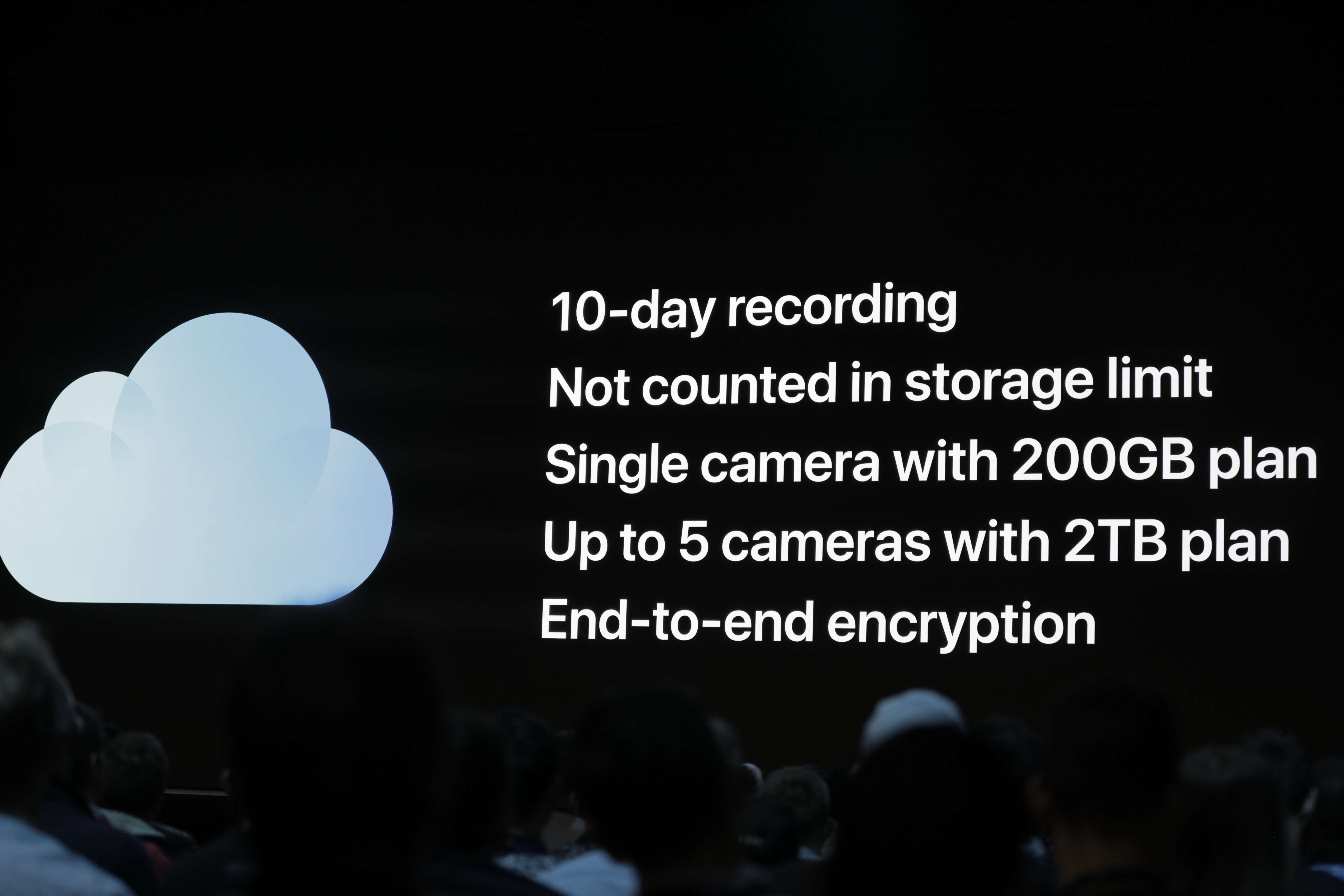
iMessage gets more personal
iMessage still feels like an improved version of SMS. Apple is going to make it more like WhatsApp. With iOS 13, you’ll be able to add a profile picture and share it with your contacts, and you’ll get to control who can see your profile picture.
Apple is using this opportunity to improve Memoji with more customization options. And the company is going one step further by copying Bitmoji and creating stickers with your Memoji.
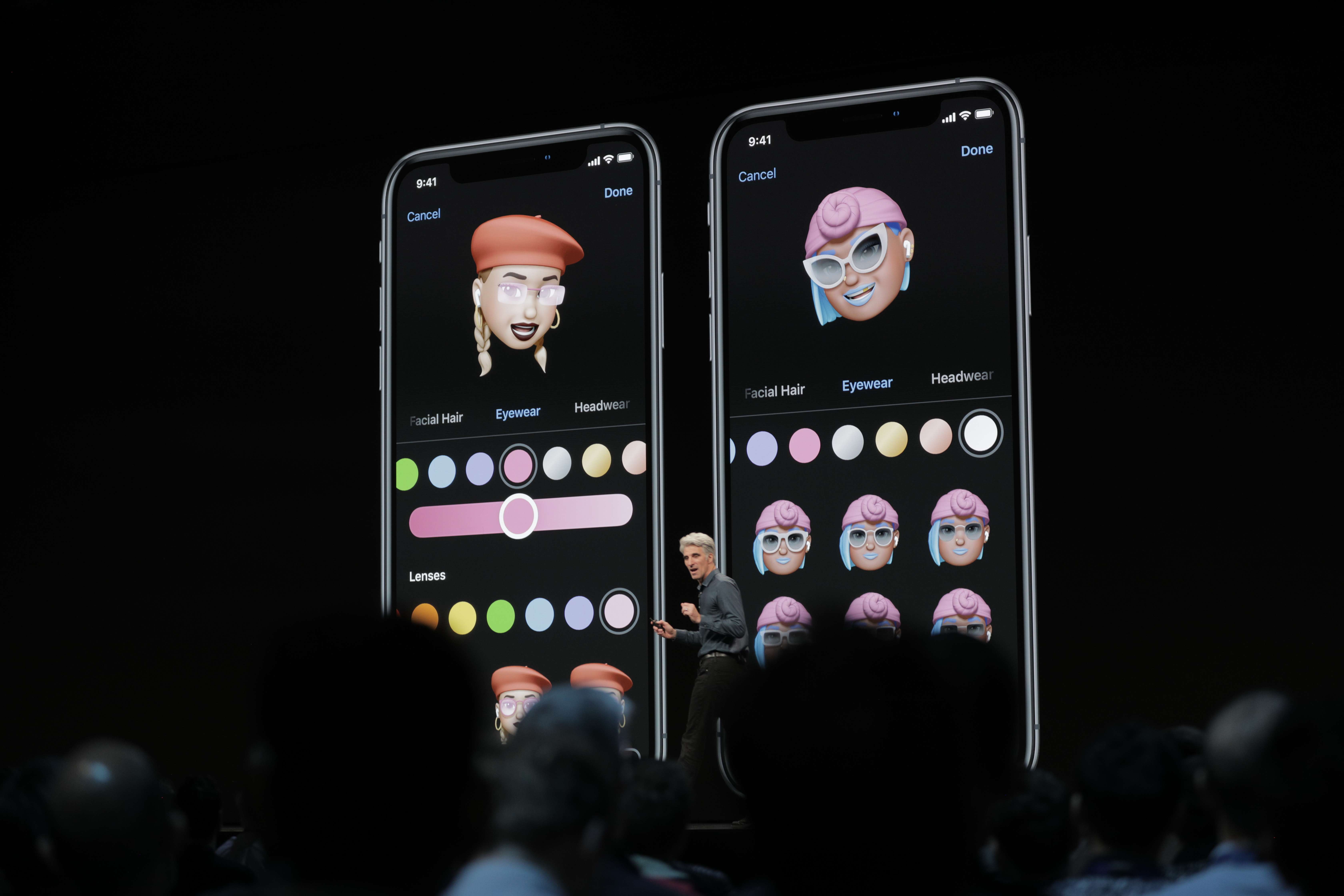
Photos
On the photo front, Apple is adding a new portrait lighting effect — and portrait lighting will become more customizable. The camera app is getting more pro features with buttons to control saturation, highlights, shadows, etc. All of this will be available for videos, as well. And Instagram users will love that you’ll be able to rotate videos.
When it comes to your photo library, iOS automatically hides duplicates photos to keep the best shot. There’s also a new tab to explore your photo library. Navigating your library feels more fluid with autoplaying video vignettes. There’s a new tab bar so that you can see highlights from the past years, months and days.
Siri gets smarter
Apple is adding more voice features across the board. For instance, when you receive a message and you’re wearing AirPods, you can hear the message you just received and reply.
If you want to watch a video or listen to music together, you can share audio with someone else who has an iPhone and a pair of AirPods. I don’t think it means that you’ll be able to stream music to two pairs of AirPods — you still need two iOS devices (update: nope, you can pair two pairs of AirPods with one iOS device).
On the HomePod front, you can tap your phone on your HomePod to send audio to your HomePod. The smart speaker is also getting support for live radio stations — I can’t believe it wasn’t already available. You’ll finally be able to set up multiple users for the HomePod to control your own calendar, messages, music and get personalized results.
CarPlay is also receiving an update with better Siri features. You can now control third-party apps, such as Pandora or Waze, with Siri. And the Siri animation doesn’t fill up the entire screen anymore.
On iOS 13, the Shortcuts app will be installed by default. You’ll get recommendations for shortcuts that could help you. And Siri should sound better overall with new voice-generating software.
There are plenty of other new features in iOS 13, especially on the iPad. If you want to read more about iPadOS, read our separate post.
Powered by WPeMatico


